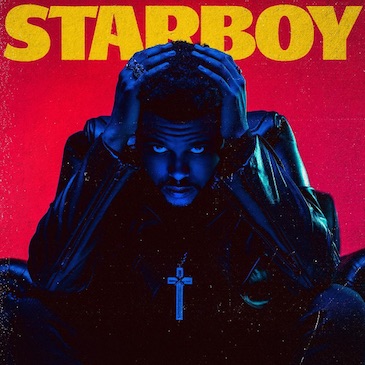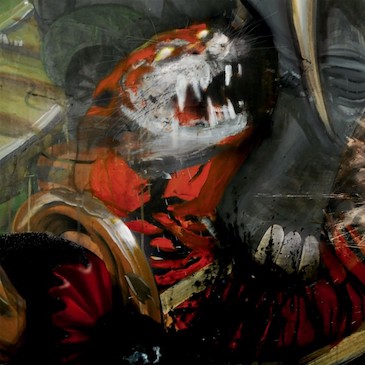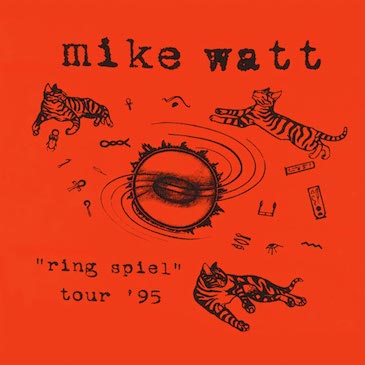Quick Spins: The Weeknd, Sleigh Bells, Mike Watt, Sting, Taylor Hawkins
By Tankboy in Arts & Entertainment on Dec 1, 2016 6:24PM

Sleigh Bells, photo by Jim Kopeny / Tankboy
Quick Spins is our semi-regular tour through new and recent releases worth your while. Consider this your quick cheat sheet on what to load up on your earbuds if you're looking for something new.
It's been a rough couple of weeks. Let's dive into some recent releases that might help us feel good about the world around us. Maybe these odds and sods can help perk up your final month before 2017.
 Abél Tesfaye made his name with dystopia late night club anthems of regret. Since then Tesfaye has come to the other side—he’s now the source of all those regrets.
Abél Tesfaye made his name with dystopia late night club anthems of regret. Since then Tesfaye has come to the other side—he’s now the source of all those regrets.
Starboy continues to build on last year's Beauty Behind The Madness and make The Weeknd’s assault on mainstream pop total and complete. The songs are still all about late night clubs, stealing other people's girls, and the loneliness of searching for love in a broken world. But the sonic variety of Tesfaye's vocals keeps things interesting. Tesfaye's vocals swoop and dip now, eschewing his more usual approach of trying to pull off a more monochromatic stratospheric tightrope walk. Modern sounds mix with the ‘70s, unsurprisingly, but while earlier Weeknd songs felt like explorations, the work on Starboy feels assured. But this isn’t the perfection of a formula: this is Tesfaye finally stepping off the tightrope into a comfort zone. That could have resulted in a stultifying traipse down memory lane, but the collaborators on Starboy help make certain that doesn’t happen.
And, come on. The Daft Punk additions really help kick the album into gear. Throw in some goodness from Cashmere Cat and the return of Max Martin and you have a winner.
The Weeknd plays Allstate Arena on May 23, 2017
 Alexis Krauss and Derek Miller came right out of the gate with a winning formula from the very first Sleigh Bells song; mix massive crunching chords with distorted beats and top with sing-song vocals equally at home on a playground or in a horror movie soundtrack. On Jessica Rabbit, the duo follows this same base approach with minor tweaks to keep the proceedings from feeling like they are simply treading water. Krauss’ vocals are shedding a bit of their simple playfulness in favor of a slightly more soulful approach, and this minor tweak helps make Jessica Rabbit feel like a move forward without leaving any of the band’s winning elements behind.
Alexis Krauss and Derek Miller came right out of the gate with a winning formula from the very first Sleigh Bells song; mix massive crunching chords with distorted beats and top with sing-song vocals equally at home on a playground or in a horror movie soundtrack. On Jessica Rabbit, the duo follows this same base approach with minor tweaks to keep the proceedings from feeling like they are simply treading water. Krauss’ vocals are shedding a bit of their simple playfulness in favor of a slightly more soulful approach, and this minor tweak helps make Jessica Rabbit feel like a move forward without leaving any of the band’s winning elements behind.
Sleigh Bells knows what works, and they keep that intact. But the band is smart enough to keep making subtle changes to their approach without overhauling the formula, so their new work always sounds fresh, but not off base. In less capable hands this would translate to “debut album part XX”. But Miller is smart enough to refine what appears on the surface to be a sledgehammer approach ever so slightly. Thus, he reveals that the songs that feel so straightforward at first actually hide a sly sophistication underneath the layers of noise.
“Rule Number One” encapsulates this shifting move forward rather eloquently. It capitalizes on the band’s tried and true tropes in its set-up before allowing Krauss room to breathe a gospel-tinged delivery before the chorus slams in to knock the listener to the ground. We're 60 years in from the genre's start, and this band is still finding ways to make three chords and the truth sound fresh and new. Sleigh Bells is one of those bands.
Mike Watt
"ring spiel" tour '95
 1995 was a weird year. The “alt-rock” explosion was in full swing with the first wave of bands like Nirvana and Pearl Jam still struggling with mainstream success. Mike Watt was a hero to many of these folks, which explains why the former Minutemen bassist was able to recruit members of Nirvana, Pearl Jam and Sonic Youth (amongst others) to contribute to his first solo album Ball-Hog or Tugboat?
1995 was a weird year. The “alt-rock” explosion was in full swing with the first wave of bands like Nirvana and Pearl Jam still struggling with mainstream success. Mike Watt was a hero to many of these folks, which explains why the former Minutemen bassist was able to recruit members of Nirvana, Pearl Jam and Sonic Youth (amongst others) to contribute to his first solo album Ball-Hog or Tugboat?
So when Watt put together a tour behind this debut, it wasn’t surprising that a number of nascent superstars embraced the idea of jumping back into the van(s) to play shows in venues a fraction of the size most folks expected to see them in. Vedder’s instrumental psychedelic band with his then-wife opened the shows, and the middle slot was taken by a then unproven live band called Foo Fighters. And for Watt’s sets on the tour, Vedder would play guitar and supply back-up vocals, Grohl would hop between guitar and drums and Pat Smear would anchor the stage with a smile and some additional killer guitar leads. The tour’s set at The Metro happened to get recorded and has spent years bouncing around the channels of legendary bootlegs.
(An aside: I was at this show. I have amazing auxiliary stories around this show that will one day probably propel an amazing book. One of these stories involves Vedder leaving messages on my then Zach Morris-sized brick of a mobile phone; not because I had any deep connection to Vedder but because I was one of the few people who had access to a cellphone at the time. Anyway.)
"ring spiel" tour '95 is a rarity amongst live albums. Watt and his crew discovered the recording existed and decided to just release it into the wild, warts and all. No overdubs, and barely any equalization of the levels that came through the board during that evening. This album sounds exactly like the show I remember seeing. And it proves that a group of musicians who hadn’t spent hours in a basement perfecting their delivery could come together to translate sometimes knotty compositions into something wonderfully compelling. Few live albums capture the actual looseness and spontaneity of a live show, and even fewer can offer a snapshot of so many legends offering their talents as journeymen in service of songs and nothing more, but "ring spiel" tour '95 accomplished all of the above and more. It’s not Live At Leeds, but it is required listening that won’t feel like homework, not even for a single second.
 Usually I regard "classic artists returning to their roots" albums with great suspicion. And 57TH & 9TH is no amazing piece of work. But it is good. Better than it should be. And it reminds me there need not be any dead ends in rock.
Usually I regard "classic artists returning to their roots" albums with great suspicion. And 57TH & 9TH is no amazing piece of work. But it is good. Better than it should be. And it reminds me there need not be any dead ends in rock.
This new Sting album is being touted as his “return to rock.” And it's not, no matter how many late night talk show appearances or awards show performances the man undertakes in order to promote that thesis statement. And I think Sting knows this; in a number of interviews he’s admitted that while his recorded forays over the last decade have edged into ever more esoteric musical territories, his live shows have remained pretty, well, rock and roll. But what I think is being underplayed is that someone I thought was hamstrung by their own history and preconceived public expectations can manage to create something that exceeds all those expectations.
57TH & 9TH will greatly please the WXRT bunch that flocked to The Police reunion shows a few years ago. But I think it may also appeal to listeners less familiar with Sting’s musical history—people better versed in Sting yoga- or Dune-related jokes—as songs like “I Can’t Stop Thinking About You” or “Petrol” prove the one-time Gordon Sumner still has a couple pop hits in him that surface his past while still proving the man has a future that need not drown in sentimentality.
Also, speaking of Sting’s numerous TV appearances lately; anyone else convinced the man is just aging backwards by this point?
Sting plays Aragon Ballroom on March 3, 2017
 Here’s an idea—a drummer from an incredibly popular mainstream rock band with punk rock roots branches off to produce a solo effort that shows there’s more to their musical prowess than a couple encyclopedias full of amazing drum fills might otherwise imply. Taylor Hawkins has a long history of laying down tasty licks behind the kit, most notably as a member of Foo Fighters, but on KOTA Hawkins straps on an ax and takes the mic to prove he’s got the chops to be considered as something more.
Here’s an idea—a drummer from an incredibly popular mainstream rock band with punk rock roots branches off to produce a solo effort that shows there’s more to their musical prowess than a couple encyclopedias full of amazing drum fills might otherwise imply. Taylor Hawkins has a long history of laying down tasty licks behind the kit, most notably as a member of Foo Fighters, but on KOTA Hawkins straps on an ax and takes the mic to prove he’s got the chops to be considered as something more.
KOTA is a good, old fashioned fun™ listen. At it’s core the EP is basically Hawkins stitching together all his favorite '70s and '80s riffs, keyboard flourishes and pop drum fills together into a single, sticky, satisfying candy concoction. Each song borrows prog rock structuring to allow Hawkins to pack as many different changes and disparate period elements into 3 to 5 minutes as he can possibly manage without causing aural whiplash. Based on this approach, Hawkins was smart to make it a single EP instead of trying to stretch it into a full album, and the final track listing offers just the right amount of cheesy fun while still feeling like an accomplished exercise in rock and not some schoolyard tribute to his influences. KOTA won’t change the world, but it will remind you there’s plenty of good times still to be had on the road ahead.